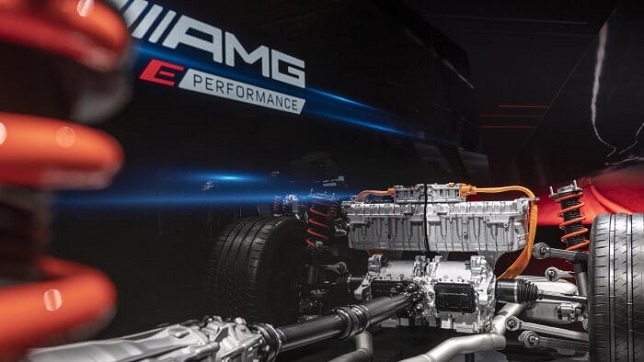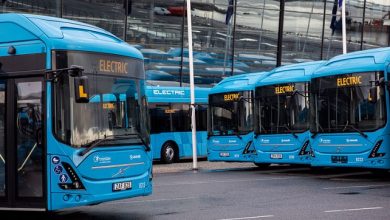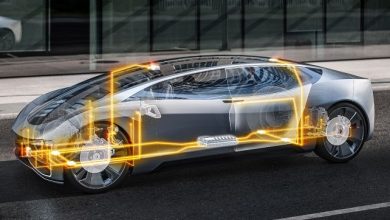Mercedes-AMG defines the future of Driving Performance
New drive strategy with performance hybrids and battery-electric AMG derivatives

With the future electrification of the drivetrain, Mercedes-AMG is combining superior performance and impressive driving dynamics with maximum efficiency. The development of future drive concepts has benefited and will continue to benefit from the valuable experience gained from close cooperation with the Formula 1 experts at Mercedes-AMG High Performance Powertrains (HPP) and the Mercedes-AMG Petronas F1 Team. The cooperation between the three performance specialists will be intensified even further in 2021, which will be reflected, among other things, in the bundling of motorsport activities. Above all, however, the mutual transfer of knowledge also makes fascinating AMG models possible, such as the Project ONE hypercar, which brings Formula 1 hybrid technology almost one-to-one to the road. Further electrified road models will debut later this year. The new drive strategy rests on two pillars: on the one hand, on the offer of performance hybrids with a completely independent drive concept under the technology label E PERFORMANCE. The second pillar is formed by battery-electric AMG derivatives based on the new Mercedes Electric Vehicle Architecture (EVA) for luxury- and premium-class vehicles. Extensive modifications to the drive, chassis, design and equipment offer the hallmark emotively appealing AMG driving experience even with all-electric drive.
“With our new drive strategy, we are transporting our hallmark DNA into an electrified future. Our performance hybrids, developed entirely in Affalterbach, will even surpass the driving dynamics of our current models and thus absolutely do justice to our new technology label E PERFORMANCE. With the all-electric derivatives based on the Mercedes-EQ models, we as Mercedes-AMG are also continuing to take off with the electrification of the portfolio. We are thus opening ourselves up to new target groups who can experience Mercedes-AMG as the Performance Luxury brand of the 21st century,” says Philipp Schiemer, Chairman of the Board of Management of Mercedes-AMG GmbH.
“Mercedes-AMG has always stood for top performance and maximum driving dynamics. When developing our new E PERFORMANCE hybrid strategy, it was therefore immediately clear that we would pursue an independent concept for AMG. The layout with the combustion engine at the front and Electric Drive Unit on the rear axle offers numerous advantages. The resulting optimised weight distribution, the best possible utilisation of torque and the very immediate power output promise driving dynamics at the highest level. Added to this is the High Performance Battery we developed, which boasts twice the power density of conventional drive batteries and, like many other components, is inspired by technology from Formula 1,” says Jochen Hermann, Chief Technical Officer of Mercedes-AMG GmbH.
Completely newly developed performance hybrid with innovative AMG concept
The independent E PERFORMANCE drivetrain strategy is based on the guiding principle of developing an electrified drivetrain that further enhances the brand’s signature Driving Performance and driving dynamics, while also being highly efficient. With the increase in performance due to the additional electric motor, the development team was also able to improve the efficiency of the entire vehicle in parallel – and achieve lower emissions as well as lower consumption.
The exclusive vehicle architecture also offers the additional benefits of all-electric driving and external charging at a wallbox, public charging station or household socket. In addition, electrification helps to maintain or even exceed today’s high AMG performance level in the future, even with smaller combustion engines.
As a performance hybrid, the modular AMG concept combines the AMG eight-cylinder or four-cylinder engine with a permanently excited synchronous electric motor, a high-performance battery developed in Affalterbach and the fully variable AMG Performance 4MATIC+ all-wheel drive. The electric motor (depending on the model series, up to 150 kW output and 320 Nm torque) is positioned on the rear axle, where it is integrated with an electrically shifted two-speed transmission and the electronically controlled rear axle differential lock in a compact Electric Drive Unit (EDU). Experts refer to this layout as a P3 hybrid. The lightweight high-performance battery is also located in the rear above the rear axle. This design results in numerous advantages especially for sports cars and performance models:
- The electric motor, developed exclusively by AMG, acts directly on the rear axle (without a diversion via the AMG SPEEDSHIFT MCT-9G transmission) and can therefore convert its power more directly into propulsion – for that extra boost when pulling off, accelerating or overtaking.
- Moreover, the power of the electric motor is applied immediately with full torque, as is characteristic for the design, so that particularly agile starting behaviour is possible.
- In addition, the integrated, electronically controlled rear axle differential lock can allocate the optimum torque to each rear wheel depending on the driving situation. The result is that the driver immediately experiences a noticeable increase in performance because the hybrid vehicle accelerates even more agilely out of corners.
- If the slip on the rear axle increases, the drive power of the electric motor is also transferred to the front wheels for a short time as needed for more traction. This is made possible by the mechanical connection of the fully variable all-wheel drive through the cardan shaft and the drive shafts of the front wheels.
- The positioning on the rear axle improves the weight as well as the axle load distribution in the vehicle and thus forms the basis for the convincing handling.
- The AMG concept also offers a very high level of efficiency in recuperation, because this system in principle allows only minimal mechanical and hydraulic losses from the engine and transmission.
- The modular concept can be rolled out across several model series and thus provides the flexibility to lead the AMG portfolio into the electrified future.
- Because the electric motor operates independently of the AMG SPEEDSHIFT MCT 9G transmission, the efficiency of the drive is also improved.
- The automated two-speed transmission on the rear axle with its specially tuned gear ratio ensures the spread from high wheel torque for agile pulling off to safe continuous performance at higher speeds. An electric actuator switches to the 2nd gear at approx. 140 km/h at the latest, which corresponds to the maximum speed of the electric motor of approx. 13,500 rpm.
Inspired by Formula 1, developed in Affalterbach: AMG High Performance Battery
When defining the electrification strategy, it was clear from the outset that all essential components would be developed in Affalterbach. At the heart of this is the AMG High Performance Battery (HPB) for the upcoming performance hybrid models. Development of the lithium-ion energy storage system began in 2016 and was inspired by technologies that have proven themselves in the Mercedes-AMG Petronas F1 Team’s Formula 1 hybrid racing cars under the toughest conditions. In the course of development, there was a lively exchange of expert knowledge between the High Performance Powertrains (HPP) Formula 1 engine forge in Brixworth and Mercedes-AMG in Affalterbach. The specifications were quickly defined: The AMG High Performance Battery combines high power that can be called up frequently in succession with low weight to increase the overall performance of the vehicle. Added to this are the fast energy absorption and the high power density. This means that, on a fast drive, for example in hilly terrain, the full power potential can be called up immediately uphill, while recuperation is strong when driving downhill.
Each battery requires a defined temperature for optimum power output. If the energy storage unit becomes too cold or too hot, it temporarily and tangibly loses power or even has to be turned down in order not to be damaged when the heat level is too high. Even temperature control of the battery therefore has a decisive influence on its performance, service life and safety. Conventional cooling systems, which only cool with air or indirectly cool the entire battery pack with water, quickly reach their limits – especially as the requirements continue to increase due to increasingly energy-dense cells. If thermal management does not optimally fulfil its function, there is also a risk of premature ageing of the battery.
The innovation push: the direct cooling of the battery cells
The basis for the high performance of the AMG 400-volt battery is the innovative direct cooling: For the first time, the 560 cells are cooled individually; they are thus permanently surrounded by a high-tech coolant based on an electrically non-conductive liquid. For the direct cooling, the AMG specialists had to develop new cooling modules that are only millimetres thin. Around 14 litres of coolant circulate from top to bottom through the entire battery past each cell with the help of a specially developed high-performance electric pump, also flowing through an oil/water heat exchanger attached directly to the battery. This conducts the heat into one of the vehicle’s two low-temperature (LT) circuits and from there on to the LT radiator at the front of the car, which finally releases the heat into the ambient air. The system is designed to ensure even heat distribution in the battery.
For high continuous output and double peak output always in the optimum temperature window
The result is that the battery is always in a consistent, optimal working temperature window of 45 degrees Celsius, no matter how often it is charged or discharged. Conventional cooling systems cannot cope with this, and the battery can no longer fully utilise its capacity. That is not the case with the AMG High Performance Battery: even during fast laps in hybrid mode on the race track, where acceleration (battery is discharged) and deceleration (battery is charged) are frequent, the energy storage system retains its high performance capacity.
On the test bench, prototypes of the battery have already completed countless test kilometres without any problems. Vehicle testing shows permanently high performance and long service life.
Effective direct cooling also makes it possible to use cells with very high power density in the first place. Due to this individual solution, the battery system could be designed in a particularly light and compact manner. The low weight is also due to the material-saving busbar concept and the light but also stable crash structure of the aluminium housing. It ensures the highest level of safety.
High-performance battery with 70 kW continuous power and 150 kW peak power
Mercedes-AMG is launching with the internally named HPB80 variant with 6.1 kWh capacity, 70 kW continuous power and 150 kW peak power for ten seconds. It weighs 89 kilograms and therefore achieves a power density of 1.7 kW/kg. Conventional batteries without direct cooling of the cells manage about half this value.
Due to the scalability of the battery, it would also be conceivable in principle to have further expansion stages follow. For this purpose, the requirements per segment are closely examined.
“Always on” operating strategy: electrical power always available
The basic operating strategy is derived from the hybrid powerpack of the Mercedes-AMG Petronas Formula 1 race car. As in the top class of motorsport, maximum propulsion is always available when the driver needs it – for example, to accelerate powerfully out of corners or when overtaking. For this purpose, the hybrid system is “always on”: the electric power can always be called up and frequently reproduced via high recuperation performance and on-demand recharging. The independent battery concept enables the optimal compromise between maximum driving dynamics and contemporary efficiency. All components are perfectly coordinated: The performance gain can be experienced immediately.
The six AMG DYNAMIC SELECT drive programs “Electric”, “Comfort”, “Sport”, “Sport+”, “RACE” and “Individual” are precisely tailored to the new drive technology and thus offer a wide-ranging driving experience – from highly efficient to highly dynamic. The drive programs adjust important parameters such as the response of the drive and transmission, the steering characteristic, the chassis damping or the sound. The programs are selected using the paddle in the centre console or the AMG steering wheel buttons and are then visualised in the instrument cluster and on the multimedia display.
Usually, the performance hybrid starts silently (“Silent Mode”) in the “Comfort” drive program when the electric motor is switched on. In the instrument cluster, the “Ready” icon signals that the vehicle is ready to drive. A light tap on the accelerator pedal is all it takes to set the AMG Performance Hybrid in motion.
- “Comfort” drive program: the start-up is mostly electric. Combustion engine and electric motor run situationally – with electric drive at low speeds, for example in residential areas or in the city centre, hybrid driving with combustion engine and electric motor in the countryside and on the motorway. Overall, the result is a harmonious and consumption-optimised driving impression, thanks in part to the early upshifts of the AMG SPEEDSHIFT MCT-9G transmission. Suspension and steering are set up for an emphasis on comfort. The steering focus is on energy efficiency, so that fuel consumption and emissions can be reduced. The hallmark AMG sportiness and agility are retained.
- “Electric” drive program: all-electric driving from a standstill up to 130 km/h, the combustion engine always remains switched off. In its basic configuration, the performance hybrid is rear-wheel drive. However, the mechanical connection to the AMG Performance 4MATIC+ components means that all-wheel drive is also available if required: if, for example, the rear wheels suddenly lose traction, the power of the electric motor is also transmitted to the front wheels via the cardan and drive shafts. When the battery is empty, the intelligent operating control automatically switches to the “Comfort” drive program and the combustion engine starts up and takes over the drive power.
- “Sport” drive program: start off with combustion engine and electric motor and situational interaction of the two drives. The boost function of the electric motor is released earlier. Sporty driving impression due to more agile response to accelerator pedal commands, shortened shift times and earlier downshifts plus more dynamic tuning of suspension and steering.
- “Sport+” drive program: start off with combustion engine and electric motor and situational interaction of the two drives. Even higher boost performance. Extremely sporty character thanks to even more agile throttle response and targeted torque intervention during upshifts with cylinder blanking for optimum shift times. Increased idle speed for faster pulling away. An even more dynamic setup for suspension, steering and drivetrain.
- “RACE” drive program: for highly dynamic driving on enclosed race tracks. In this program, all of the parameters are configured for maximum performance. Pulling off with combustion engine and electric motor and situational interaction of the two drives. Full electric boost power from the electric motor to support the combustion engine during hard acceleration. Strong battery recharging at low power demand for maximum electrical availability.
- “Individual” drive program: individual customisation of the drive, transmission, AMG DYNAMICS, chassis, steering and exhaust system.
The control of vehicle dynamics also benefits from the hybrid drive. Instead of a decelerating brake intervention by ESP®, the electric motor can regulate traction as soon as a wheel signals too much slip. The ESP® does not have to intervene at all or only later. Advantage: the combustion engine can thus be operated with higher torque, which both improves agility afterwards and increases efficiency. In addition, the power otherwise “destroyed” during braking can be used to charge the battery.
The AMG Performance hybrids also have the integrated AMG DYNAMICS vehicle dynamics control system. It influences the control strategies of the ESP® (Electronic Stability Program), the all-wheel drive, and the electronically controlled rear-axle differential lock. This increases agility without negatively affecting the vehicle’s stability.
Particularly noteworthy: AMG DYNAMICS determines how the vehicle should react. The system uses the available sensors, among other things, to ascertain the speed, lateral acceleration, steering angle and yaw rate. Thanks to an intelligent pilot-control principle, it is possible to anticipate how the driver wants the vehicle to behave, based on the driver’s actions and on data from the sensors. Regulation is tailored to the dynamic driving competence of the driver – without any noticeable or disruptive interventions by the system. The driver gets a very authentic driving feel with high cornering dynamics and optimum traction, as well as high stability and predictable handling. Even experienced drivers receive optimum assistance without feeling patronised by the system.
- AMG DYNAMICS “Basic” is assigned to the “Comfort” and “Electric” drive program. The design results in a very stable ride with high yaw damping.
- “Advanced” is activated in the “Sport” program. The vehicle remains neutrally balanced. The reduced yaw damping and increased agility support dynamic manoeuvres such as driving on winding country roads.
- “Pro” (abbreviation for “Professional”) is part of the “Sport+” program. In “Pro” the driver receives even more assistance for dynamic driving manoeuvres while agility and feedback from the road when cornering are further enhanced.
- “Master” is coupled with the drive program “RACE”. “Master” mode is aimed at drivers who want to experience dynamism and the driving enjoyment on closed-off circuits. “Master” offers a slightly oversteering vehicle balance, more direct steering and more agile turn-in behaviour. In this way, “Master” ensures maximum agility and optimally exploits the dynamic potential of the “S” version. To activate “Master” mode, the driver must use the separate button in the centre console to switch the ESP® to ESP® SPORT Handling Mode or ESP® OFF.
In the “Individual” drive program, the driver can set the AMG DYNAMICS levels “Basic”, “Advanced”, “Pro” and “Master” themselves.
Recuperation selectable in four stages
Because the high-performance battery is always in the optimum temperature window of around 45 degrees due to direct cooling, recuperation can also be optimised – normally, a battery heats up strongly when recuperation power is too high, so that energy recovery has to be reduced.
Recuperation starts when the driver only takes their foot off the accelerator pedal, i.e. in overrun mode without touching the brake pedal. This not only charges the battery, but also creates a strong braking torque – the wheel brakes are spared or, depending on the traffic situation, do not have to be applied at all. The driver can select four different levels of recuperation power from the right-hand AMG steering wheel button. This applies in all drive programs, although the energy recuperation is designed differently depending on the drive program.
- Level 0: The vehicle behaves similarly to a conventional combustion engine with manual transmission, where the clutch is disengaged, and rolls on with the least resistance when the accelerator is released. The recuperation power is very low and only serves to maintain the vehicle’s power supply. With the combustion engine switched off, friction losses in the drivetrain are maximumly reduced.
- Level 1: This is the standard setting at which recuperation is already noticeable to the driver and roughly corresponds to the deceleration of a conventional, engaged combustion engine.
- Level 2: Stronger recuperation, the brake pedal hardly needs to be depressed when moving in traffic.
- Level 3: Highest energy recovery of up to 90 kW possible here via “one-pedal” driving as in an all-electric car. This takes some getting used to and can also be irritating during fast laps on the race track: here, the racer wants to get the last bit of time out on the brakes. Therefore, in the “RACE” drive program, recuperation is automatically set to level 1 in order to achieve the most reproducible vehicle behaviour possible (high efficiency is still ensured, however, as energy recovery takes place when the brake is applied).
Another advantage of recuperation is that the vehicle does not speed up when driving down steep hills. So the system works like an engine brake, but also feeds energy into the battery.
Let numbers speak: over 600 kW system power and more than 1000 Nm system torque
The outstanding performance of the AMG Performance Hybrid drivetrain speaks for itself: more than 600 kW system power and over 1000 Nm system torque are technically possible. Depending on the future vehicle, this enables acceleration from 0 to 100 km/h in less than 3.0 seconds. The immediate response of the electric drive, the rapid torque build-up and the optimised weight distribution in the vehicle enable new best values in longitudinal and lateral dynamics. The extremely immediate reactions to every movement of the accelerator pedal are particularly inspiring in every driving situation. This drivetrain is planned for several model series in various expansion stages. In order to be able to incorporate the changing market and customer requirements into future products, the final specification of engine and performance values is still open at the present time.
The next stage: E PERFORMANCE with 2.0-litre four-cylinder engine and electric exhaust-gas turbocharger
Parallel to the development of the eight-cylinder performance hybrids, the next technological stage is taking place: AMG Performance Hybrid in combination with the AMG four-cylinder turbo engine. The 2.0-litre engine with the internal designation M 139 has so far been used in the compact performance models installed transversely. As an E PERFORMANCE variant, it will also provide a fitting drive in other future Mercedes-AMG model series. However, it will be installed longitudinally, thoroughly reworked and its performance significantly increased once again. The engineers are aiming for the further developed M 139 to once again surpass the world’s highest litre output of all four-cylinder series engines.
The biggest innovation is the electric exhaust-gas turbocharger, which is being realised for the first time in a production vehicle. This technology comes directly from Formula 1 and is called MGU-H (Motor Generator Unit Heat). The identical system already powers the Mercedes-AMG Project ONE hypercar.
Lightning-fast response, more agile than a naturally aspirated V8 engine
The electric exhaust-gas turbocharger solves the conflict of objectives between a small, fast-responding turbocharger, which however achieves comparatively low peak power, and a large turbocharger with high peak power, which in turn responds with a significant delay.
Exhaust-gas turbocharger with integrated electric motor: agility redefined
The highlight of this innovative turbocharging system: a four-centimetre-narrower electric motor is integrated directly on the shaft of the exhaust-gas turbocharger (charger shaft), between the turbine wheel on the exhaust gas side and the compressor wheel on the fresh air side. Electronically controlled, this directly drives the shaft of the exhaust-gas turbocharger and thus accelerates the compressor wheel before the exhaust gas flow takes over the drive. The electrification of the turbocharger significantly improves immediate response from idle speed and across the entire engine speed range.
The result is that the combustion engine responds even more immediately to accelerator pedal input, and the entire driving feel is significantly more dynamic and agile. In addition, the electrification of the turbocharger enables higher torque at low engine speeds compared to non-electrified turbocharging, which also increases agility and optimises acceleration from a standstill. Even when the driver takes their foot off the accelerator or applies the brakes, the technology of the electric turbocharger is able to maintain the boost pressure at all times, so that a continuous direct response is ensured.
The turbocharger is operated with the 400-volt on-board power supply and thus achieves speeds of up to 156,000 rpm, which allows a very high air flow. The supercharger and electric motor are connected to the high-temperature cooling circuit of the combustion engine to create the best possible temperature environment at all times. The power electronics are cooled via the low-temperature circuit.
Future four-cylinder hybrid at the performance level of the current V8 engine with exhaust-gas turbocharging
In the four-cylinder Performance Hybrid, the powerful AMG 2.0-litre turbo engine (with electric exhaust-gas turbocharger) with more than 330 kW can be combined with an electric motor developing up to 150 kW. The total power and the total torque enable future AMG models to achieve driving performance that even surpasses comparable, current vehicles with V8 engines without hybrid drive. The high agility, performance and efficiency of the hybrid 4-cylinder drivetrain will initially be launched in the future generation of the Mercedes-AMG C-Class.
Belt-driven starter-alternator as standard
The four- and eight-cylinder performance hybrids also receive a belt-driven starter-alternator (RSG) that combines the alternator and starter in one component and produces 10 kW (14 hp). It starts the combustion engine and ensures the basic supply of the auxiliary units such as air conditioning or driving lights, for example, when the vehicle is at a traffic light and the charge level of the high-voltage battery is no longer sufficient to support the low-voltage on-board network. The RSG is particularly responsive because it is integrated into the 400-volt high-voltage grid.
100 percent emotions, zero emissions: all-battery-electric AMG vehicles about to go into series production
In addition, Mercedes-AMG is also developing performance vehicles with all-battery-electric drive. Exclusive, individualised as well as performance-enhanced AMG models are currently being created on the basis of upcoming Mercedes-EQ electric cars – similar to today’s Mercedes-AMG E-Class based on a Mercedes-Benz model, known as the AMG derivative strategy. The market launch will begin this year.
The first battery-electric AMG models are based on the new, electro-exclusive Mercedes-EQ architecture. The vehicles are extensively redeveloped in Affalterbach specifically for each market in the areas of technology (drive, chassis, brakes, sound), exterior design, interior design as well as standard equipment and options. They are ambassadors for a new era in the performance segment of the 43 and 53 series AMG models, for target groups who place high value on innovative electric mobility but do not want to forego sportiness and agile driving dynamics.
The exterior design picks up on AMG’s characteristic elements and transfers them to the all-electric age. These include the specific radiator grille with vertical louvres, the redesigned front apron, the side sill panels, the independent rear with spoiler lip and diffuser, and AMG wheels in Aero or Heritage design.
The interior, too, is given that special sporty touch by, among other things, exclusive AMG seats with individual graphics, AMG-specific functions and displays for the MBUX displays or the AMG Performance steering wheel with integrated buttons and two round AMG steering wheel buttons. Numerous AMG options enhance the dynamic look on request.
The new performance models will launch with two independent, permanently excited synchronous machines and fully variable all-wheel drive with modular torque distribution. The preliminary performance values of the test vehicles are already very promising: From the combination of front and rear engine, overall performance can be achieved on a par with the most powerful Mercedes-AMG Performance models with the current 4.0-litre V8 biturbo engine. This also applies to the sprint from standstill to 100 km/h, which is completed in well under 4.0 seconds, depending on the power and vehicle, and whose linear acceleration is a very special pleasure. The electric motors rev up to a maximum of 18,000 rpm and enable a top speed of up to 250 km/h.
The 400-volt lithium-ion battery receives its own wiring harness, which is adapted to the higher performance capacity of the AMG derivatives. The AMG RIDE CONTROL+ air suspension is specifically tuned for optimised longitudinal and lateral dynamics. Added to this is the electro-exclusive AMG i-Booster additional function, which harmoniously combines electric recuperation and hydraulic braking during deceleration.
And of course, the hallmark AMG sound is also part of the package. With additional hardware (loudspeakers, shaker, sound generator), for example, and the newly composed, authentic “AMG Sound Experience”, Mercedes-AMG is also driving into the future in a highly emotively appealing, electric way.




